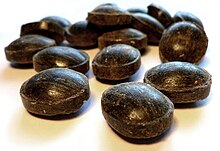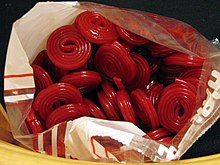Liquorice (confectionery)
 Liquorice wheels from Haribo | |
| Alternative names | Black liquorice |
|---|---|
| Type | Confectionery |
| Main ingredients | Extract of the roots of the liquorice plant, sugar, binding agent (starch, flour, gum arabic, or gelatin) |
Liquorice (
A variety of liquorice sweets are produced around the world. In North America, black liquorice is distinguished from similar confectionery varieties that do not contain liquorice extract but are manufactured in the form of similarly shaped chewy ropes or tubes and often called red liquorice. Black liquorice, together with
The essential ingredients of black liquorice confectionery are liquorice extract, sugar, and a binder. The base is typically starch/flour, gum arabic, gelatin or a combination thereof. Additional ingredients are extra flavouring, beeswax for a shiny surface, ammonium chloride and molasses. Ammonium chloride is mainly used in salty liquorice candy, with concentrations up to about 8%. However, even regular liquorice candy can contain up to 2% ammonium chloride, the taste of which is less prominent because of the higher sugar concentration.[2] Some liquorice candy is flavoured with anise oil instead of or in combination with liquorice root extract, because anise has a very similar flavour.[3]
History
In England in 1614, Sir George Savile invented the liquorice format still known as Pontefract cakes when he stamped discs of liquorice with the image of Pontefract Castle.[4] The Dunhill company are credited with the development of liquorice as a confection by adding sugar in 1760.[4]
Production

During manufacturing, the ingredients are dissolved in water and heated to 135 °C (275 °F). In order to obtain sweets of the desired shapes, the liquid is poured into molds that are created by impressing holes into a container filled with starch powder. The liquid is then dried and the resulting sweets are sprayed with beeswax to make their surface shiny.[5]
Health effects

The liquorice-root extract contains the natural sweetener
Excessive black liquorice consumption can cause
Red liquorice

In many countries there is also a product sometimes known as red liquorice (red licorice), with a recipe very similar to a common type of liquorice confection (a starchy or gummy binder with sugar added, extruded into the shape of a rope or tube with a chewy consistency), but instead of
.While the common name for these confections has become "red liquorice" or often simply "liquorice" due to their shape and texture, they do not have the taste of liquorice since there is no actual liquorice in them. "Black" in "black liquorice" would formerly have been redundant, but has become a retronym in North America.
Varieties

- Choo Choo Bar
- Crows
- Good & Plenty
- Liquorice allsorts
- London drops
- Negro, a brand of liquorice sold in Eastern Europe known for its dark colour, attributed to the use of activated carbon in its recipe
- Pontefract cake
- Red Vines
- Salty liquorice (Salmiak liquorice, a specialty popular in Finland)
- Sugarelly, a liquorice drink
- Turkish pepper
- Twizzlers, the 1845 original ones
- Victory V, liquorice throat lozenges that formerly contained ether and chloroform as active ingredients
- Vigroids
See also
References
- ^ "Liquorice". Merriam-Webster.com Dictionary.
- ^ The Dutch manufacturer Meenk offers detailed ingredient lists of its products: regular Archived 30 September 2007 at the Wayback Machine and salty Archived 30 September 2007 at the Wayback Machine liquorice candy (in Dutch).
- ^ a b Black Licorice: Trick or Treat? from US Food & Drug Administration, Consumer Updates, 25 Oct 2011.
- ^ ISBN 978-1-5267-7888-8.
- ^ Perry Romanowski, How Products are Made: Licorice Archived 2 November 2011 at the Wayback Machine, at enotes.com
- PMID 11494093.
- PMID 31379750.
- PMID 32966726.
- AP News. Retrieved 23 September 2020.
Sources
 Media related to Liquorice as food at Wikimedia Commons
Media related to Liquorice as food at Wikimedia Commons- Liquorice at www.food-info.net
